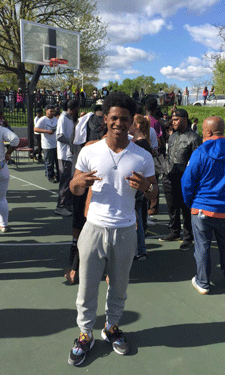 April 12, 25-year-old Freddie Gray was severely injured while in Baltimore Police custody. According to reports, the young man’s spine was almost completely severed at his neck and officers waited 45 minutes before calling for medical help. Soon after, Gray would succumb to his injuries and his death would ignite a firestorm of protests across the city.
April 12, 25-year-old Freddie Gray was severely injured while in Baltimore Police custody. According to reports, the young man’s spine was almost completely severed at his neck and officers waited 45 minutes before calling for medical help. Soon after, Gray would succumb to his injuries and his death would ignite a firestorm of protests across the city.
Baltimore is no stranger to tension between police personnel and the citizens patrolled, often low-income and people of color. According to a September 2014 Baltimore Sun investigation, between 2010-2014, “more than 100 people have won court judgments or settlements [against the Baltimore Police Department] related to allegations of brutality and civil-rights violations.” Similar statistics and anecdotes of police-perpetuated violence from long-time residents have been plastered across television screens, newspapers and the Internet in the days following Gray’s death, painting a bleak picture of Charm City.
But, despite the heavy coverage of intense protests and a handful of incidents of violence and looting, another story is beginning to emerge — one of community, unity, compassion and support originating from the grassroots. For as deeply as Baltimore residents are hurt by the tension and violations that have most recently swept their city, they are equally as motivated to show their neighborly love and community pride. The City of Baltimore Department of Recreation and Parks (BCRP) has been at the forefront of that effort, providing for its constituents’ need to connect to one another and contribute to healing Baltimore.
Safe Haven
Peaceful protests turned ugly Monday, April 27, as a small group of individuals attacked several businesses in West Baltimore, smashing windows, looting, setting cars ablaze and clashing with police. As a result, officials established a city-wide curfew, a state of emergency was instituted and schools were closed Tuesday, April 28.
Despite the chaos, BCRP recognized many residents, particularly youth, would need a safe place to go while school was out of session. The agency extended its community center hours to accommodate anyone who wanted to congregate, recreate and find a sense of calm amid the tension. BCRP’s goal, as stated by Chief of Recreation Center Operations Tracey Estep, was “to offer a safe haven and resource to families.” “We wanted to provide quality recreation and leisure programs to any resident or community member coming into the centers…our after-school programs were also in session so kids could come, have access to a hot meal in the afternoon and a safe haven from the turbulence going on in the streets of Baltimore.”
Community Outreach
While Baltimore residents were welcomed inside the city’s community centers, BCRP personnel also extended their efforts into the streets to assist in clean-up efforts and offer additional support where requested. BCRP Public Information Officer Arli Lima also stressed the agency’s special facilities continued to operate amid the protests, offering still more opportunities for youth to work out any stress or anxiety. “We have a special facility literally blocks from where everything was going on,” Lima says. “Upton Boxing remains open and committed to servicing the youth of our community. Our skating and bowling facility is also open.”
April 28, BCRP joined forces with the mayor’s office and the Baltimore City Youth Commission to host an upbeat block party at the Cloverdale basketball courts, a much-appreciated distraction from the tense atmosphere blanketing the area. Dozens of young people, including well-known 15-year-old student athlete and Upton Boxing star Lorenzo Simpson, spent the day playing basketball, listening to music, dancing, eating and showing support for their city. The party was “just blocks from North and Pennsylvania Avenues,” Lima says, where much of the unrest took place, but that didn’t stop people like Simpson from “going out in the community and speaking about non-violence.”
Ongoing Support
Both Lima and Estep were buoyed by the outpouring of support shown to their agency by the community at large. Whole Foods and the Family League of Baltimore offered donations of healthy food to serve at area recreation centers and countless individuals have reached out with financial contributions and a desire to volunteer.
BCRP has also received hundreds of messages of thanks for its efforts during the protests. “From a communications standpoint, we have received massive online support through Facebook, Twitter and Instagram — we’ve gotten more retweets than I’ve ever seen,” Lima says. “A lot of people are posting, ‘Thanks for supporting the youth.’ So it’s been very positive.”
Estep says people have also been personally calling their recreation centers to thank staff for keeping the centers open, hosting community events and giving folks a safe, positive environment in which to gather and support each other. “Under the leadership of [Mayor Stephanie Rawlings-Blake] and [BCRP Director] Ernie Burkeen, we have a mission,” she says. “It’s a core component of what we’re offering to all our residents. We want them to know we’re here for them — we’re here as a hub of the community and a resource for youth. We’re not just here for kids to play sports, we’re here for civic and community engagement. We hear the community — we hear their voices and we are trying to give them every aspect of recreation, leisure, health and wellness and be a meeting place where they gather and help get our city back to where it was before the incidents that occurred on Monday.”
Samantha Bartram is the Associate Editor of Parks & Recreation magazine.

